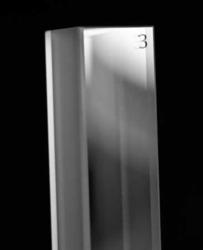Feb 21 2011
Based on today's industry standards, a spectrophotometer cuvette is typically made from either an optical glass or synthetic fused silica quartz material. There are many different brands and qualities of these materials.
For example, an optical glass cuvette can be made from borosilicate, crown glass, borofloat, Pyrex ®, and various other types of glass.
 NSG Spectrophotometer Cuvette
NSG Spectrophotometer Cuvette
Using the highest grade quartz is critical to making high quality spectrophotometer cuvettes. Quartz also has a few different brands, and subsequently, slightly differing properties. One popular type of fused silica quartz is NSG's ES Quartz, also know as Extrasil Quartz. This type of quartz has superior optical and chemical characteristics and has been used for making reliable spectrophotometer cuvettes for many years. Using the ES Quartz has given NSG an edge due to the fact that using highest grade synthetic quartz material ensures scientists receive the most accurate results.
Cuvette assembly also affects its quality. A common mistake is that people think cuvettes are make from one block of quartz or glass. Actually cuvettes are generally constructed from 4-5 plates of glass or quartz.
There are a few different methods for assembling a spectrophotometer cuvette. The most common method is using fire to melt the two plates together, this is known as fire fusing. The cheaper, less reliable way of assembling a cuvette by a glass frit compound. This technique is call fritting, and is popular among Chinese cuvette manufacturers due to the low cost, and less skill required. The best technique for assembling cuvettes is using low pressure thermal fusion. At present, only NSG Precision Cells and 1-2 other companies can do this.
NSG Precision Cells only uses thermal fusion for their products, leaving the inferior methods of cuvette assemble to other companies who don't take high quality seriously.
NSG's thermal fusing is a standard requirement for companies who use flow cytometry cells (flow channel cells) in their equipment. Additionally, the ES Quartz thermally fused flow cytometry cells and cuvettes can handle high pressure, and can withstand high output lasers without taking any damage.
Polishing is a critical component of producing good spectrophotometer cuvettes. The better a window or plate is polished, the better the optical transmission. Precision Cells polishing is done using special polishing powders that range from very coarse, to very fine. The polishing powder is placed in an automated polishing machine that rotates and polishes the plates and gives them a perfectly even polish.
Having accurate and precise data will save researchers time, money, and many headaches. Research engineer Simcha Dov quotes, "Using a spectrophotometer cuvette that is made from NSG's high quality materials on ISO certified machines, will provide scientists with the most accurate results in their research."
Purchasing a spectrophotometer cuvette from a reliable and established manufacturer, such as NSG is highly recommended. There are many fly-by-night Chinese manufacturers who are trying to take advantage of their cheap manufacturing costs. However, their cuvettes have been known to leak (poor fusing/fritting), and have inferior transmission (poor quality materials). It's entirely possible that this technology is in its infancy in China, but may come to realization in the future.
However, researchers are learning that the cuvettes purchased from these Chinese factories have to be replaced with cuvettes from NSG Precision Cells due to the poor results they receive.